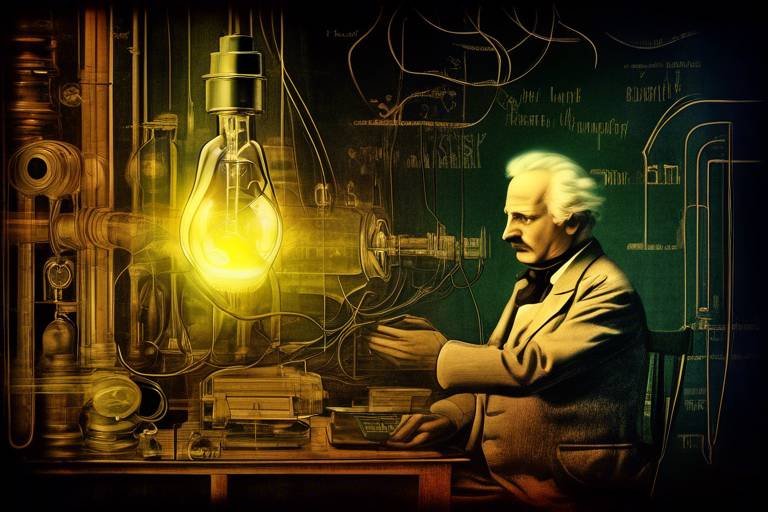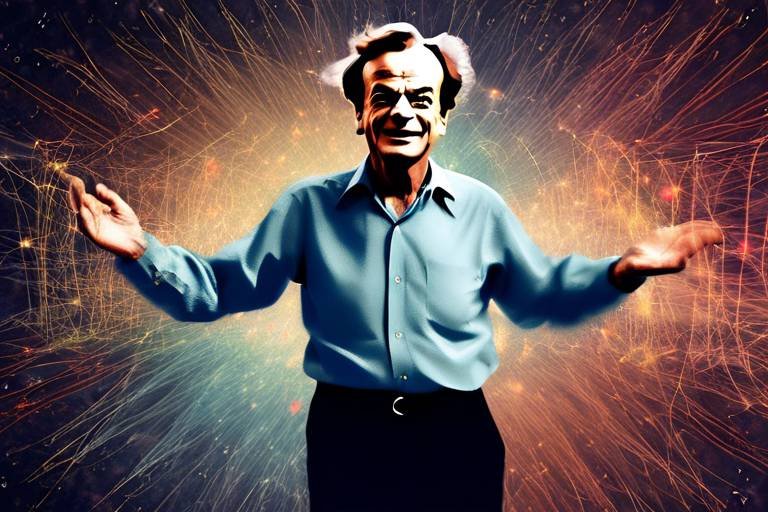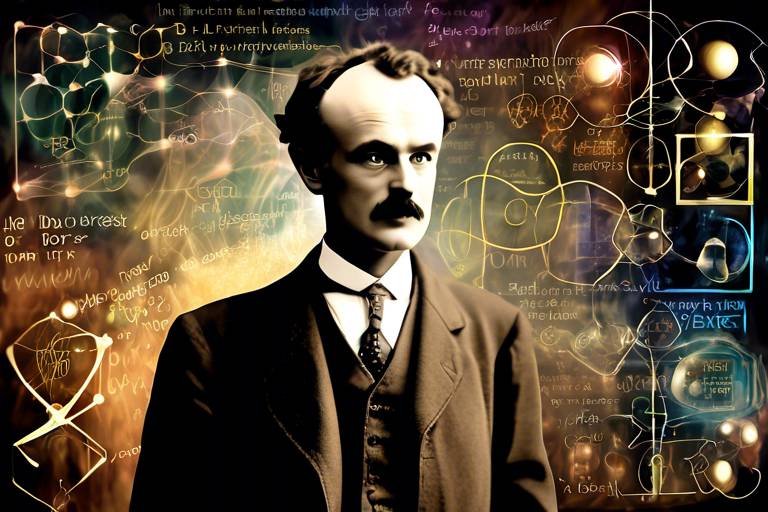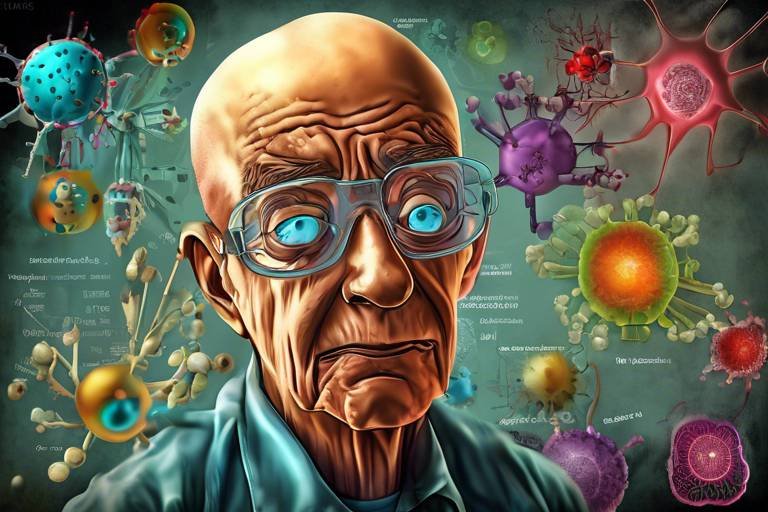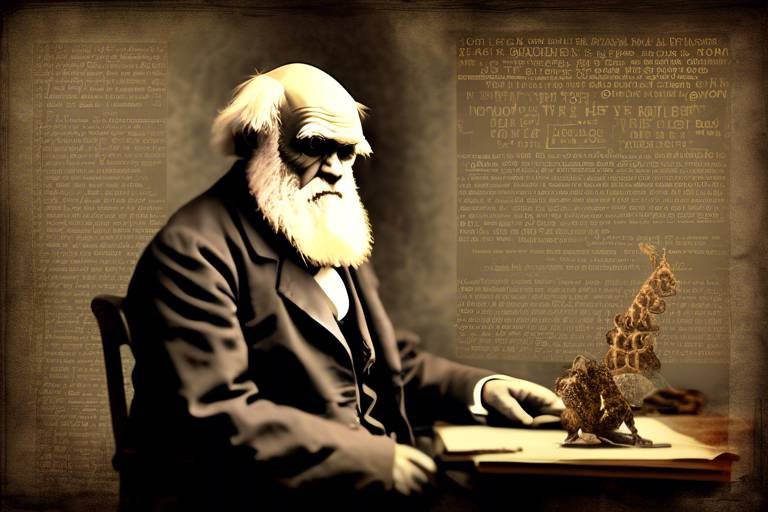The Work of Hermann von Helmholtz in Energy Conservation
Hermann von Helmholtz was a pivotal figure in the realm of physics, and his contributions to the principle of energy conservation have left an indelible mark on modern science. Born in 1821, Helmholtz was not just a physicist; he was a polymath whose interests spanned across physiology, psychology, and even philosophy. His work on energy conservation is particularly noteworthy, as it laid the groundwork for future scientific advancements and reshaped our understanding of energy in physical systems. So, what exactly did Helmholtz do that was so revolutionary? Well, buckle up, because we’re about to dive into the fascinating world of energy conservation through the eyes of one of history's great minds.
Helmholtz's journey began in a rather humble setting. Growing up in a small town in Prussia, he was exposed to the wonders of nature and science at an early age. His education at the University of Berlin was crucial, where he was influenced by prominent figures such as Alexander von Humboldt. It was here that Helmholtz developed a keen interest in the laws of nature and the energetic processes that govern them. This early exposure to scientific inquiry and rigorous academic training set the stage for his groundbreaking work on energy conservation.
In the mid-19th century, the concept of energy was still in its infancy. Many scientists were grappling with the idea that energy could neither be created nor destroyed, only transformed from one form to another. Helmholtz articulated this principle with remarkable clarity, providing a framework that not only explained existing observations but also predicted new phenomena. His seminal paper, "On the Conservation of Force," published in 1847, was a turning point that captured the essence of this principle. He argued that all forms of energy—whether kinetic, potential, thermal, or chemical—are interchangeable, a concept that was revolutionary at the time.
To support his theories, Helmholtz employed a range of mathematical tools. He utilized calculus to formulate equations that described energy transformations quantitatively. This was no small feat, as it required a deep understanding of both mathematics and physics. By establishing mathematical relationships between different forms of energy, Helmholtz created a solid foundation upon which future scientists could build. For instance, he showed how potential energy could be converted into kinetic energy and vice versa, illustrating the dynamic nature of energy in physical systems.
Helmholtz's insights didn't stop at theoretical formulations; he also explored the implications of energy transformations. He emphasized the interplay between potential and kinetic energy, which was revolutionary in understanding how energy behaves in various systems. Imagine a roller coaster: as it climbs to the top, it accumulates potential energy, and as it plunges down, that energy transforms into kinetic energy. Helmholtz's work provided the scientific basis for understanding such phenomena, making it easier for future researchers to study complex systems.
Moreover, Helmholtz's contributions had profound implications for thermodynamics. His work laid the groundwork for the laws of thermodynamics, particularly the first law, which is essentially a restatement of the conservation of energy principle. This connection was crucial for the development of modern physics, influencing everything from steam engines to refrigerators. The understanding that energy cannot be created or destroyed but only converted from one form to another is a cornerstone of physical science today.
Helmholtz didn't just theorize; he also conducted experiments that provided empirical support for his ideas. His experiments demonstrated energy conservation in various physical systems, showcasing how energy transformations occur in real-world applications. This blend of theory and experimentation is what makes Helmholtz's work so compelling. He was not just a thinker; he was a doer, and his experiments helped solidify the conservation of energy as a fundamental principle in physics.
Today, Helmholtz's contributions continue to resonate within the scientific community. His work has paved the way for advancements in various fields, from engineering to environmental science. The principles of energy conservation are now integral to our understanding of everything from climate change to renewable energy sources. In a world grappling with energy challenges, Helmholtz's legacy serves as a reminder of the importance of understanding energy dynamics.
- What is the conservation of energy principle? The conservation of energy principle states that energy cannot be created or destroyed, only transformed from one form to another.
- How did Helmholtz contribute to this principle? Helmholtz articulated the conservation of energy principle in his seminal work and provided mathematical frameworks and experimental evidence to support it.
- Why is Helmholtz's work important today? His contributions laid the groundwork for modern physics and are essential for understanding energy dynamics in various scientific fields.

Helmholtz's Early Life and Education
Hermann von Helmholtz was born on August 31, 1821, in Potsdam, Prussia, a town steeped in history and intellectual fervor. His early life was marked by a strong educational foundation, thanks to his father, who was a teacher and instilled in him a love for learning. From a young age, Helmholtz exhibited a keen interest in the sciences, particularly in physics and mathematics, which would later become the cornerstones of his groundbreaking work in energy conservation.
Helmholtz's formal education began at the Gymnasium in Potsdam, where he excelled in subjects like physics and mathematics. His academic prowess earned him a scholarship to the University of Berlin, where he studied medicine. However, it was during his time at university that he began to delve deeper into the realms of physics and physiology, ultimately leading him to explore the principles of energy. The vibrant intellectual environment of Berlin, filled with the ideas of contemporaries such as Alexander von Humboldt and Johann Wolfgang von Goethe, greatly influenced Helmholtz's thinking and scientific approach.
In 1843, Helmholtz completed his medical degree, but his passion for physics led him to pursue a career in that field. He became a professor at the University of Königsberg, where he began to conduct experiments and formulate theories that would later contribute to the conservation of energy principle. Helmholtz's early research focused on the conservation of force, which he articulated in his seminal paper, "On the Conservation of Force," published in 1847. This work laid the groundwork for his later contributions to the understanding of energy transformations and the laws of thermodynamics.
Helmholtz's education was not solely confined to the classroom. He was an avid reader and often engaged in discussions with fellow scientists, which helped him refine his ideas. His ability to integrate knowledge from various disciplines—such as biology, chemistry, and physics—allowed him to approach problems from unique angles. This interdisciplinary method became a hallmark of his scientific career, leading to innovations that would shape modern physics.
In summary, Helmholtz's early life and education were characterized by a rich tapestry of experiences that fostered his scientific curiosity. The combination of a supportive family, a rigorous academic environment, and a passion for exploration set the stage for his later achievements in energy conservation. His journey from a young student in Potsdam to a prominent physicist serves as an inspiring reminder of how foundational education can influence groundbreaking discoveries.

The Conservation of Energy Principle
The principle of energy conservation is one of the cornerstones of physics, and Hermann von Helmholtz played a pivotal role in shaping our understanding of this fundamental concept. In the 19th century, when scientific thought was rapidly evolving, Helmholtz articulated the idea that energy cannot be created or destroyed; it can only change forms. This revolutionary notion challenged previously held beliefs and laid the groundwork for modern physics. Imagine energy as a shape-shifting entity, constantly transforming from one form to another—like water flowing through different terrains, adapting but never vanishing. This analogy captures the essence of energy conservation.
Helmholtz's formulation of this principle was not merely theoretical; it was grounded in rigorous empirical evidence and mathematical precision. He proposed that the total energy of an isolated system remains constant over time, which implies that the sum of potential energy and kinetic energy within that system will always balance out. This idea resonated with the scientific community, as it provided a cohesive framework for understanding various physical phenomena, from the mechanics of moving objects to the behavior of heat and thermodynamic processes.
To grasp the significance of Helmholtz's contributions, it's essential to understand how he articulated the conservation of energy principle in the context of the scientific debates of his time. Before Helmholtz, many scientists were exploring energy in isolation—focusing on heat, motion, or light as separate entities. Helmholtz unified these concepts, showing that they are interconnected and governed by the same underlying principles. This integration was revolutionary, as it allowed scientists to predict the behavior of physical systems with greater accuracy.
Helmholtz's work also emphasized the importance of energy transformations. He explored how energy could transition from potential energy—stored energy based on an object's position or configuration—to kinetic energy, which is the energy of motion. For instance, consider a roller coaster: at the top of a hill, it possesses maximum potential energy. As it descends, that potential energy is converted into kinetic energy, propelling the coaster forward at exhilarating speeds. This interplay of energy forms is crucial for understanding everything from simple machines to complex biological systems.
Moreover, Helmholtz's insights had profound implications for the burgeoning field of thermodynamics. His work laid the foundation for the laws of thermodynamics, which govern energy transfer and conversion processes. The first law of thermodynamics, often referred to as the law of energy conservation, directly stems from Helmholtz's principles. This law states that energy within a closed system is constant, and any change in energy must come from energy transfer into or out of the system. In essence, Helmholtz's ideas helped to establish a scientific framework that would guide researchers for generations to come.
In summary, Helmholtz's contributions to the conservation of energy principle were nothing short of transformative. He not only articulated the concept with clarity and precision but also provided the mathematical and experimental foundations that would support it. His work bridged the gap between theoretical physics and practical applications, influencing countless fields and setting the stage for future discoveries. As we delve deeper into the implications of his work, we begin to see how it continues to resonate within modern physics and beyond.
- What is the conservation of energy principle?
The conservation of energy principle states that energy cannot be created or destroyed, only transformed from one form to another. - How did Helmholtz contribute to this principle?
Hermann von Helmholtz articulated the conservation of energy principle, providing both theoretical and experimental support for its validity in various physical systems. - Why is energy conservation important in physics?
Energy conservation is crucial because it helps scientists understand how energy interacts within systems, guiding research in mechanics, thermodynamics, and even modern technologies.

Mathematical Foundations
Hermann von Helmholtz's work on energy conservation wasn't just groundbreaking in its conceptualization; it was also deeply rooted in rigorous mathematical foundations. His ability to articulate complex ideas through mathematics allowed him to bridge the gap between abstract theory and practical application. Helmholtz utilized various mathematical tools, primarily calculus, to describe the behavior of energy within physical systems. This approach was revolutionary for the time, as it provided a quantitative framework to understand how energy is conserved and transformed.
One of the key aspects of Helmholtz's mathematical framework was his use of the principle of conservation of energy. He articulated that energy can neither be created nor destroyed; it can only change forms. This idea can be expressed mathematically as:
E_initial E_final
In this equation, E_initial represents the total energy before any transformation, while E_final signifies the total energy after the transformation. Helmholtz's insights allowed scientists to quantify energy changes in various systems, leading to a more profound understanding of physical phenomena.
Helmholtz also explored the relationship between different types of energy, such as kinetic energy (the energy of motion) and potential energy (stored energy). The mathematical expressions for these forms of energy are:
| Type of Energy | Mathematical Expression |
|---|---|
| Kinetic Energy | KE 1/2 mv² |
| Potential Energy | PE mgh |
In these equations, m represents mass, v is velocity, g is the acceleration due to gravity, and h is height. Helmholtz's ability to interrelate these forms of energy mathematically laid the groundwork for what would become a cornerstone of classical mechanics.
Moreover, Helmholtz's work emphasized the importance of energy transformations. He demonstrated that energy could be transformed from one type to another without loss, which was a radical departure from earlier notions that energy could simply disappear. This insight is crucial in understanding not only mechanical systems but also biological processes, where energy transformation is fundamental to life itself.
In summary, Helmholtz's mathematical foundations for energy conservation were not merely an afterthought; they were integral to his theories. By employing calculus and establishing clear mathematical relationships, he provided a robust framework that continues to influence physics today. His legacy is evident in how we understand energy dynamics in everything from simple machines to complex ecosystems.
- What is the conservation of energy principle?
The conservation of energy principle states that energy cannot be created or destroyed; it can only change forms.
- How did Helmholtz contribute to thermodynamics?
Helmholtz's work laid the foundation for thermodynamics by establishing the relationship between energy conservation and heat transfer.
- What mathematical tools did Helmholtz use?
Helmholtz primarily used calculus to describe energy transformations and conservation quantitatively.

Energy Transformations
When we think about energy transformations, it's like watching a magician perform a trick where one form of energy seamlessly morphs into another. Hermann von Helmholtz was a pioneer in understanding these magical transformations, particularly the interplay between potential and kinetic energy. His insights into how energy can neither be created nor destroyed, but merely transformed from one form to another, laid the groundwork for modern physics. Imagine a rollercoaster: at the top, the ride is full of potential energy, just waiting to be unleashed. As it plunges downwards, that potential energy transforms into kinetic energy, propelling the coaster forward with thrilling speed. Helmholtz's theories helped us understand this fundamental principle in a more scientific context.
One of the most revolutionary aspects of Helmholtz's work was his ability to articulate the concept of energy transformations in a way that was both mathematically rigorous and intuitively understandable. He introduced the idea that energy transformations are not just random occurrences but are governed by specific laws. For instance, consider a swinging pendulum. At its highest point, all the energy is potential, but as it swings down, that potential energy converts into kinetic energy, and back again as it rises. This continuous transformation illustrates a fundamental principle of physics that Helmholtz articulated with clarity.
To further illustrate the significance of energy transformations, let's look at a simple table that summarizes some common forms of energy and their transformations:
| Type of Energy | Transformation Example |
|---|---|
| Potential Energy | Water stored in a dam |
| Kinetic Energy | A moving car |
| Thermal Energy | Heat from a burning fuel |
| Chemical Energy | Food being metabolized |
Helmholtz's exploration of energy transformations was not merely theoretical; he conducted numerous experiments that provided empirical evidence for his claims. His investigations into the conservation of energy showed that, no matter the system, energy remains constant, even as it changes form. This principle is crucial in fields ranging from mechanical engineering to biology, where understanding energy flow is essential for innovation and sustainability.
Moreover, the implications of Helmholtz's work extend beyond physics; they resonate in everyday life. For example, consider how a car engine operates: it transforms chemical energy from fuel into mechanical energy that powers the vehicle. This transformation is not only vital for transportation but also presents challenges and opportunities in energy efficiency and environmental sustainability. Helmholtz's insights into energy transformations thus continue to inspire scientists and engineers as they seek to optimize energy use in our modern world.
In summary, Hermann von Helmholtz's contributions to understanding energy transformations have had a profound and lasting impact on the scientific community. His ability to illustrate how energy shifts from one form to another, governed by natural laws, has paved the way for advancements in various fields, ensuring that his legacy endures in the ongoing quest to harness and conserve energy efficiently.
- What is energy transformation? Energy transformation refers to the process of changing energy from one form to another, such as potential energy converting to kinetic energy.
- Why is Helmholtz's work important? Helmholtz's work established foundational principles in energy conservation, influencing modern physics and engineering practices.
- How do energy transformations affect our daily lives? Energy transformations are crucial in various applications, from transportation to heating, affecting efficiency and sustainability in everyday activities.

Implications for Thermodynamics
Hermann von Helmholtz's groundbreaking work on energy conservation didn't just create ripples; it sent shockwaves through the field of thermodynamics. Imagine a world where the principles governing heat and energy were still in their infancy—Helmholtz stepped in like a guiding star, illuminating the path for future scientists. His formulation of the conservation of energy principle laid the essential groundwork for the laws of thermodynamics, fundamentally changing our understanding of physical processes.
At the heart of thermodynamics are its four laws, which describe how energy is transferred and transformed. Helmholtz's insights were crucial in establishing the first law of thermodynamics, which states that energy cannot be created or destroyed, only transformed from one form to another. This principle is not just a theoretical concept; it has practical implications that affect everything from how we design engines to how we understand biological systems. For instance, when you think about a car engine, it converts chemical energy from fuel into mechanical energy, demonstrating Helmholtz's ideas in action.
To further understand the implications, let’s break down some key contributions Helmholtz made to thermodynamics:
- Energy Transformations: Helmholtz emphasized the importance of energy transformations, showcasing how potential energy could be converted into kinetic energy and vice versa. This insight was revolutionary for understanding mechanical systems.
- Equilibrium and Stability: His work also touched on the concepts of equilibrium and stability in thermodynamic systems, which are crucial for predicting how systems behave under various conditions.
- Interdisciplinary Influence: Helmholtz's theories influenced not only physics but also chemistry and biology, as the principles of energy conservation apply across these disciplines.
Moreover, Helmholtz’s understanding of energy conservation laid the foundation for later developments in statistical mechanics, a branch of physics that explains how macroscopic properties of materials arise from the behavior of their microscopic constituents. This connection between macroscopic and microscopic worlds is a testament to the depth of Helmholtz's insights.
In summary, the implications of Helmholtz's work on thermodynamics are profound and far-reaching. By establishing the principle of energy conservation, he not only provided a framework for the laws of thermodynamics but also influenced a multitude of scientific fields. His legacy is evident in the way we understand energy today, reminding us that in the grand scheme of the universe, energy is the thread that weaves all physical phenomena together.
- What is the conservation of energy principle? The conservation of energy principle states that energy cannot be created or destroyed, only transformed from one form to another.
- How did Helmholtz's work influence thermodynamics? Helmholtz's work laid the groundwork for the laws of thermodynamics, particularly the first law, which is centered on energy conservation.
- What are the practical applications of Helmholtz's theories? His theories have applications in various fields, including engineering, chemistry, and biology, influencing everything from engine design to understanding biological processes.

Experimental Evidence
Hermann von Helmholtz was not just a theorist; he was a pioneer who sought to substantiate his ideas with rigorous . His experiments were designed to showcase the fundamental principle of energy conservation, demonstrating that energy could neither be created nor destroyed, only transformed from one form to another. One of the most notable experiments involved the conversion of mechanical energy into heat, which he meticulously documented to highlight the interdependence of various energy forms. This investigation was pivotal in proving that energy remains constant within a closed system, a concept that was revolutionary at the time.
In his experiments, Helmholtz utilized a range of apparatuses to measure energy transformations. For instance, he conducted experiments using pendulums to illustrate how potential energy converts into kinetic energy and vice versa. By measuring the height of the pendulum swing and the speed at its lowest point, he was able to calculate the energy at different stages of the swing. His findings consistently showed that the total mechanical energy remained constant, reinforcing the conservation principle.
Helmholtz also explored the relationship between heat and mechanical work. He conducted experiments that involved heating a gas and measuring the resulting pressure changes, which further illustrated the conversion of thermal energy into mechanical energy. This was crucial in establishing the groundwork for the laws of thermodynamics. The implications of his findings were profound; they not only supported his theoretical assertions but also paved the way for future explorations in both physics and engineering.
To summarize some of Helmholtz's key experiments and their implications, consider the following table:
| Experiment | Energy Transformation Observed | Significance |
|---|---|---|
| Pendulum Experiment | Potential to Kinetic Energy | Demonstrated conservation of mechanical energy |
| Gas Heating Experiment | Thermal to Mechanical Energy | Supported the relationship between heat and work |
| Calorimetry | Heat Measurement | Provided empirical evidence for energy transformations |
Through these experiments, Helmholtz not only validated his theoretical claims but also set a standard for scientific inquiry that emphasized the importance of empirical evidence. His work demonstrated that to understand the universe, one must observe and measure, a principle that remains at the core of scientific investigation today. Helmholtz’s experimental evidence laid the groundwork for future physicists, who would build upon his findings to further explore the intricate dance of energy in all its forms.
- What is the conservation of energy principle? The conservation of energy principle states that energy cannot be created or destroyed; it can only change forms.
- How did Helmholtz contribute to thermodynamics? Helmholtz's work established foundational concepts in thermodynamics, particularly regarding the conversion of different energy forms.
- What types of experiments did Helmholtz conduct? Helmholtz conducted various experiments, including pendulum swings and gas heating, to demonstrate energy transformations.

Impact on Modern Physics
The contributions of Hermann von Helmholtz to the principle of energy conservation have had a profound and lasting impact on modern physics. His insights didn't just shape the scientific understanding of energy; they fundamentally altered the trajectory of multiple scientific disciplines. Think of Helmholtz as a bridge connecting classical physics with the emerging theories of the 20th century, such as quantum mechanics and relativity. His work laid the groundwork for a more unified understanding of energy, which has since become a cornerstone of physics.
One of the most significant impacts of Helmholtz's work is the way it influenced the development of the laws of thermodynamics. Before Helmholtz, the concept of energy was somewhat nebulous, but his formulation of energy conservation provided a solid framework that scientists could build upon. This was particularly crucial during the 19th century, a time when scientific inquiry was rapidly evolving and the need for a coherent theory of energy was becoming increasingly apparent. Helmholtz's ideas were instrumental in establishing the first and second laws of thermodynamics, which describe how energy is conserved and transformed in physical systems.
Moreover, Helmholtz's emphasis on the interconvertibility of different forms of energy—such as kinetic and potential energy—has had far-reaching implications across various fields. For example, in mechanical engineering, understanding energy transformations is essential for designing efficient machines. In biology, his principles have been applied to understand metabolic processes, where energy conversion is vital for sustaining life. Helmholtz's theories serve as a common language that unites diverse scientific disciplines, from physics to biology to engineering.
Helmholtz's work also paved the way for future research in energy conservation technologies. The principles he articulated are now foundational in the development of renewable energy sources and energy-efficient systems. As we face global challenges related to energy consumption and sustainability, Helmholtz's legacy becomes even more relevant. His insights encourage scientists and engineers to innovate and find new ways to harness and conserve energy, highlighting the practical applications of his theoretical work.
In addition to influencing the scientific community, Helmholtz's work inspired a generation of scientists who followed in his footsteps. Figures like Max Planck and Albert Einstein drew upon Helmholtz's ideas as they formulated their theories, demonstrating the ripple effect of his contributions. The interconnectedness of scientific ideas is much like a web; each strand represents a different theory or discovery, and Helmholtz's work is a vital thread that strengthens the entire structure.
In summary, the impact of Hermann von Helmholtz on modern physics cannot be overstated. His formulation of the conservation of energy has not only enriched our understanding of the physical world but has also provided a framework that continues to guide scientific inquiry and technological advancement. As we continue to explore the mysteries of energy and its transformations, Helmholtz's legacy remains a beacon of inspiration for scientists and researchers alike.
- What is the conservation of energy principle?
The conservation of energy principle states that energy cannot be created or destroyed; it can only be transformed from one form to another. - How did Helmholtz contribute to thermodynamics?
Helmholtz's work provided a foundational understanding of energy conservation, which led to the formulation of the first and second laws of thermodynamics. - Why is Helmholtz's work still relevant today?
His insights into energy transformations are crucial for modern scientific research and technology, especially in the context of renewable energy and energy efficiency.

Influence on Other Scientists
Hermann von Helmholtz's groundbreaking work in energy conservation didn't just remain confined within the pages of his own studies; it rippled through the scientific community, influencing a multitude of thinkers and researchers in various fields. His formulation of the conservation of energy principle became a foundational stone upon which many subsequent theories were built. Think of it as a domino effect—once Helmholtz set the first piece in motion, it led to a cascade of discoveries that shaped modern physics.
One of the most notable figures influenced by Helmholtz was Julius Robert von Mayer, who independently formulated the law of conservation of energy around the same time. Mayer's work in thermodynamics was significantly inspired by Helmholtz's principles, particularly in understanding the conversion of heat into work. This interplay between their ideas laid the groundwork for what we now recognize as the first law of thermodynamics, which states that energy cannot be created or destroyed, only transformed from one form to another.
Furthermore, Helmholtz's insights also reached the world of thermodynamics, where they inspired scientists like Lord Kelvin and Rudolf Clausius. Their work further expanded on Helmholtz's theories, leading to the formulation of the second law of thermodynamics, which introduced the concept of entropy. This was revolutionary, as it provided a deeper understanding of energy transformations and the natural direction of energy flow in physical systems.
Helmholtz's influence extended beyond thermodynamics into the realm of electromagnetism as well. His ideas about energy conservation informed the work of James Clerk Maxwell, who developed the famous Maxwell's equations. These equations describe how electric and magnetic fields interact and propagate, demonstrating the conservation of energy in electromagnetic systems. Without Helmholtz's foundational principles, Maxwell's groundbreaking work might have taken a different trajectory.
In the 20th century, Helmholtz's legacy continued to inspire scientists like Albert Einstein. Einstein's theory of relativity, particularly the famous equation Emc², reflects the conservation of energy concept that Helmholtz championed. This equation illustrates the equivalence of mass and energy, further solidifying the idea that energy is a fundamental component of the universe. Helmholtz’s influence can be seen as a thread that connects various scientific advancements, creating a rich tapestry of knowledge that spans generations.
In summary, Hermann von Helmholtz's contributions to energy conservation not only revolutionized physics during his time but also ignited a spark that inspired countless scientists. His work served as a catalyst for future discoveries, ensuring that the principle of energy conservation remains a cornerstone of scientific exploration. The legacy of Helmholtz is a testament to the interconnectedness of scientific inquiry, where one man's ideas can illuminate the path for many others.
- What was Hermann von Helmholtz known for?
Helmholtz is best known for his formulation of the conservation of energy principle, which laid the groundwork for modern physics and thermodynamics.
- How did Helmholtz influence thermodynamics?
His work inspired scientists like Rudolf Clausius and Lord Kelvin, who built upon his ideas to develop the laws of thermodynamics.
- What is the significance of the conservation of energy principle?
This principle states that energy cannot be created or destroyed, only transformed, which is fundamental to understanding physical systems.
- Did Helmholtz's work impact modern science?
Yes, his contributions have had a lasting impact on various fields, including physics, engineering, and even biology.

Legacy and Recognition
Hermann von Helmholtz's legacy is a tapestry woven with the threads of scientific inquiry, innovation, and profound impact on multiple fields. His contributions to the principle of energy conservation were not merely academic; they laid the foundational stones for modern physics and engineering. To understand his legacy, one must look at how his ideas have permeated various disciplines, influencing everything from thermodynamics to biological sciences.
Helmholtz's work has been recognized through numerous accolades and honors, reflecting the high regard in which he is held within the scientific community. For instance, he was elected to prestigious societies such as the Royal Society in London and was awarded the Copley Medal, a testament to his groundbreaking contributions. His theories have not only stood the test of time but have also been pivotal in shaping the trajectory of scientific thought in the 19th and 20th centuries.
Furthermore, Helmholtz's influence extends beyond his immediate contributions. He inspired a generation of scientists who followed in his footsteps, including luminaries like Max Planck and Albert Einstein, who built upon his principles to explore new frontiers in physics. His ideas about energy conservation and transformations provided a framework that would eventually lead to the development of the laws of thermodynamics, which are cornerstones of modern scientific understanding.
In academia, Helmholtz is often celebrated as a polymath; he was not just a physicist but also made significant contributions to physiology and psychology. His interdisciplinary approach is a reminder of the interconnectedness of scientific disciplines. Today, many educational institutions honor his legacy by naming awards, lectures, and even buildings after him, ensuring that future generations of scientists remember the man who significantly advanced our understanding of energy.
In summary, Hermann von Helmholtz's legacy is characterized by a profound respect for the laws of nature and an unwavering commitment to scientific exploration. His recognition in the scientific community is not just a reflection of his past achievements but also a beacon guiding future research and innovation in energy conservation and beyond.
- What was Hermann von Helmholtz's main contribution to science?
Helmholtz is best known for formulating the principle of energy conservation, which states that energy cannot be created or destroyed, only transformed from one form to another. - How did Helmholtz's work influence modern physics?
His theories laid the groundwork for the laws of thermodynamics and influenced future scientists, paving the way for advancements in various fields such as physics, engineering, and biology. - What honors did Helmholtz receive during his lifetime?
Helmholtz received several prestigious awards and recognitions, including election to the Royal Society and the Copley Medal for his significant contributions to science.
Frequently Asked Questions
- What is the principle of energy conservation?
The principle of energy conservation states that energy cannot be created or destroyed; it can only be transformed from one form to another. This means that the total energy in a closed system remains constant over time, which is a fundamental concept in physics.
- How did Hermann von Helmholtz contribute to the understanding of energy conservation?
Hermann von Helmholtz formulated the conservation of energy principle in the 19th century, providing a mathematical framework and experimental evidence that supported this crucial concept. His work helped to clarify how energy can transform between potential and kinetic forms, influencing both physics and thermodynamics.
- What are some key experiments conducted by Helmholtz?
Helmholtz conducted several experiments that demonstrated energy conservation, including studies on mechanical systems and heat engines. These experiments provided empirical evidence that supported his theoretical work and helped to solidify the conservation of energy as a cornerstone of modern physics.
- What impact did Helmholtz's work have on thermodynamics?
Helmholtz's contributions laid the groundwork for the laws of thermodynamics, particularly the first law, which relates to energy conservation. His insights into energy transformations and the relationship between heat and work were pivotal in the development of thermodynamic theory.
- How is Helmholtz remembered in the scientific community today?
Helmholtz is remembered as a pioneering figure in the field of energy conservation. His legacy continues to influence modern physics and engineering, and he is celebrated for his innovative approach to understanding the fundamental principles that govern energy and its transformations.
- What mathematical tools did Helmholtz use in his work?
Helmholtz employed various mathematical tools, including calculus, to articulate his theories on energy conservation. These mathematical frameworks allowed him to quantitatively describe energy transformations and provided a solid foundation for his scientific arguments.
- Did Helmholtz influence other scientists?
Absolutely! Helmholtz's work inspired many subsequent scientists and researchers, shaping the trajectory of scientific inquiry in energy conservation and related fields. His ideas have permeated various disciplines, fostering advancements in physics, engineering, and even biology.
- What are energy transformations, and why are they important?
Energy transformations refer to the process of changing energy from one form to another, such as converting potential energy into kinetic energy. Understanding these transformations is crucial because they explain how energy flows and is utilized in physical systems, impacting everything from machinery to biological processes.

